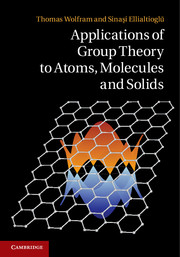Book contents
- Frontmatter
- Contents
- Preface
- 1 Introductory example: Squarene
- 2 Molecular vibrations of isotopically substituted AB2 molecules
- 3 Spherical symmetry and the full rotation group
- 4 Crystal-field theory
- 5 Electron spin and angular momentum
- 6 Molecular electronic structure: The LCAO model
- 7 Electronic states of diatomic molecules
- 8 Transition-metal complexes
- 9 Space groups and crystalline solids
- 10 Application of space-group theory: Energy bands for the perovskite structure
- 11 Applications of space-group theory: Lattice vibration
- 12 Time reversal and magnetic groups
- 13 Graphene
- 14 Carbon nanotubes
- Appendix A Vectors and matrices
- Appendix B Basics of point-group theory
- Appendix C Character tables for point groups
- Appendix D Tensors, vectors, and equivalent electrons
- Appendix E The octahedral group, O and Oh
- Appendix F The tetrahedral group, Td
- Appendix G Identifying point groups
- Index
- References
1 - Introductory example: Squarene
Published online by Cambridge University Press: 18 December 2013
- Frontmatter
- Contents
- Preface
- 1 Introductory example: Squarene
- 2 Molecular vibrations of isotopically substituted AB2 molecules
- 3 Spherical symmetry and the full rotation group
- 4 Crystal-field theory
- 5 Electron spin and angular momentum
- 6 Molecular electronic structure: The LCAO model
- 7 Electronic states of diatomic molecules
- 8 Transition-metal complexes
- 9 Space groups and crystalline solids
- 10 Application of space-group theory: Energy bands for the perovskite structure
- 11 Applications of space-group theory: Lattice vibration
- 12 Time reversal and magnetic groups
- 13 Graphene
- 14 Carbon nanotubes
- Appendix A Vectors and matrices
- Appendix B Basics of point-group theory
- Appendix C Character tables for point groups
- Appendix D Tensors, vectors, and equivalent electrons
- Appendix E The octahedral group, O and Oh
- Appendix F The tetrahedral group, Td
- Appendix G Identifying point groups
- Index
- References
Summary
In this chapter we illustrate the solution of a simple physical problem in order to familiarize the reader with the procedures used in the group-theoretical analysis. Since this is the initial chapter, we shall give nearly all of the details involved in the analysis. Some readers familiar with group theory may find that the discussion includes too much detail, but we would rather be clear than brief. In later chapters less detail will be required since the reader will by then be familiar with the analysis method.
Theorems from group theory are stated and discussed when employed in the analysis, but the proofs of the theorems are not presented in this chapter. Readers interested in the proofs can find them in Appendix B or refer to a number of excellent standard group-theory texts [1.1].
The procedures employed in this chapter are simple but somewhat tedious and not the most efficient way to analyze the simple example discussed. However, these procedures will prove extremely valuable when we are faced with more complex problems. Therefore the reader is encouraged to work through the details of the chapter and the exercises at the end of the chapter.
In-plane molecular vibrations of squarene
As an introductory example we consider a fictitious square molecule we shall call “squarene”. The squarene molecule, shown in Fig. 1.1, lies in the plane of the paper with identical atoms at each corner of a square.
- Type
- Chapter
- Information
- Publisher: Cambridge University PressPrint publication year: 2014



